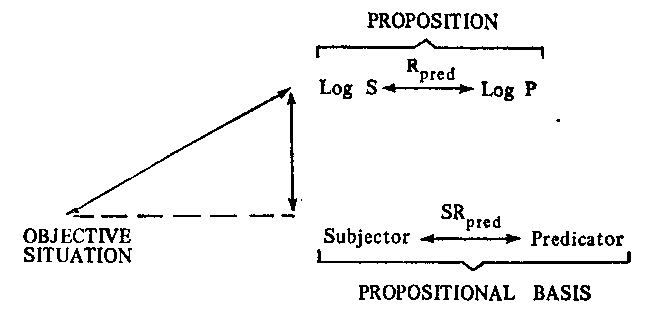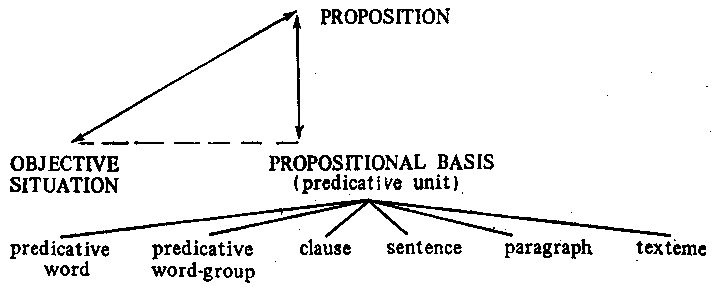
- •Часть III учение о предложении 29
- •Часть III грамматическое учение о предложении 92
- •Глава 1 предложение — единица сообщения 92
- •Иванова и.П. Бурлакова в.В. Почепцов г.Г.
- •1.6.21.1. Инфинитив
- •1.6.21.2. Причастие второе.
- •1.6.21.3. Причастие первое и герундий.
- •1.6.21.4. Причастие первое.
- •1.6.21.5. Герундий.
- •1.7. Наречие
- •3. Предложение
- •3.1. Признаки предложения (общая характеристика)
- •3.2.1.3. Статус подлежащего и сказуемого.
- •3.2.2.6. Усложнение сказуемого.
- •Смирницкий а.И. Морфология
- •Герундий и инфинитив
- •Причастие
- •Глава V
- •2. Предикат и субъект. Сказуемое и подлежащее
- •§ 74. Согласно данному в § 73 определению, сказуемое есть то слово или сочетание слов, которым выражается предикация и обозначается предикат.
- •Выражение предикации в сказуемом
- •4. Подлежащее
- •Выражение подлежащего
- •§ 84. Во многих языках для выражения подлежащего используется определенный падеж существительных, местоимений или других слов, имеющих субстантивное значение.
- •Связь между содержанием сказуемого и содержанием подлежащего
- •§ 85. Между содержанием подлежащего и содержанием сказуемого имеется известная взаимосвязь:
- •Ильиш б.А.
- •Word order some general points
- •Subject and predicate4
- •The subject and the predicate
- •Types of Predicate
- •The Participle as Predicate
- •Other Types of Nominal Predicate
- •Limits of the Compound Verbal Predicate
- •The Compound Nominal Predicate
- •Chapter XXXII transition from simple to composite sentences
- •Sentences with homogeneous parts
- •Sentences with a dependent appendix
- •Secondary predication
- •The absolute construction
- •Chapter X the simple sentence the principal parts of the sentence
- •Blokh m.Ya.
- •Chapter XI non-finite verbs (verbids)
- •Chapter XXI sentence: general
- •Chapter XXII actual division of the sentence
- •Chapter XXIII communicative types of sentences
- •§ 2. An attempt to revise the traditional communicative classification of sentences was made by the American scholar Ch. Fries who classed them, as a deliberate challenge to the
- •§ 4. The communicative properties of sentences can further be exposed in the light of the theory of actual division of the sentence.
- •§ 5. As far as the strictly interrogative sentence is concerned, its actual division is uniquely different from the actual division of both the declarative and the imperative sentence-types.
- •§ 8. In the following dialogue sequence the utterance which is declarative by its formal features, at the same time contains a distinct pronominal question:
- •§ 9. The next pair of correlated communicative sentence types between which are identified predicative constructions of intermediary nature are declarative and imperative sentences.
- •§ 10. Imperative and interrogative sentences make up the third pair of opposed cardinal communicative sentence types serving as a frame for intermediary communicative patterns.
- •Chapter XXIX semi-complex sentence
- •§ 3. Semi-complex sentences of subject-sharing are built up by means of the two base sentences overlapping round the common subject. E.G.:
- •§ 6. Semi-complex sentences of adverbial complication are derived from two base sentences one of which, the insert
- •Блох м.Я.
- •Часть III грамматическое учение о предложении глава 1 предложение — единица сообщения
- •Мороховская э.Я. Chapter XI general characteristics of predicative units
- •Predicative words
- •Predicative word-groups
Мороховская э.Я. Chapter XI general characteristics of predicative units
The predicative units of language are directly related to the entities of concept because they verbalize human thought and represent lingually the main predicative form of thought, i.e. the proposition. Taking into consideration the interaction of objective and subjective factors in language and the dialectical unity of language and thought the predicative units of language must be considered as the indirect reflections of objective situations, as the reflections of the general interrelation of everything in nature and society. But linguistic predicative units should not be identified with their conceptual correlatives since these pertain to the different realities, to lingual and conceptual respectively. Due to logicism which pervaded grammar for centuries, the sentence was unjustly identified with the proposition. The dialectical unity of language and thought presupposes the correlation of the predicative units of language with the predicative forms of thought as parts and counterparts of the dialectical unity. It is because of this unity that the analysis of the predicative units of language would be inefficient without any reference to the peculiarities of the forms of thought with which the given units correlate and which they represent lingually.
The formation of the propositions and correlatively of predicative" units in the process of verbal thinking reflects the development of thought and the establishment of the predicative relations between the constituting parts of the units. The propositions with their predicative relations embody themselves in the bases of lingual predicative units. The prepositional basis (пропозициональная база) seems to be universal due to its ability to represent the universal proposition. It follows that all languages have predicative units the nucleus or the kernel of which is identified in terms of universal lingual categories.
The kernel of the predicative unit is an exocentric construction built of universal categories. The members of the kernel (prepositional* basis) can be conventionally termed the "subjector" and the "predicator". The terms are chosen on purpose to distinguish linguistic notions from their logical correlatives: the subjector is, in fact, the linguistic representation of the logical subject and the predicator, respectively, represents the logical predicate. The relations between the constituents of the propositional basis are predicative relations correlating with the corresponding relations in the proposition.
The triangle pattern works here as usual to illustrate the correlativity of objective — conceptual — lingual facts (see p. 173).
Due to the correlation between propositions and propositional bases the typology of propositions can be extrapolated onto their linguistic counterparts. It is beyond our competence to dwell upon the typology of logical forms but the recognition of the actional propositions versus
17o

attributional ones is out of the question because they underlie the two main basic structures of predicative units: NV and N is A.

Predicative units in English are of different linguistic status: words, word-groups, clauses, sentences, etc. It is notable that all of them embody propositions in their prepositional bases.
